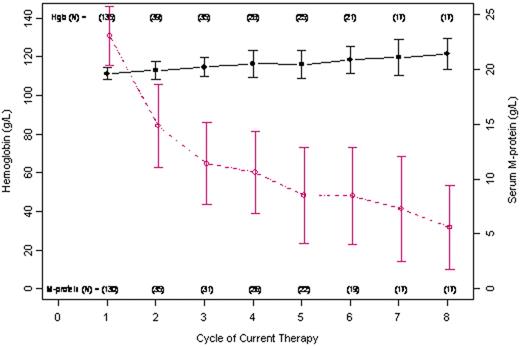Abstract
Abstract 4892
In multiple myeloma (MM), hemoglobin (Hb) levels have long been part of staging of the disease and an important determinant in assessing treatment options, response to therapy and prognosis. The causes of a low Hb level are complex, but reflect in part the extent of myeloma cell infiltration in the bone marrow. Changes in the level of the monoclonal immunoglobulin protein in the blood and/or urine (M protein) serve as the main surrogate marker for response to treatment and progression of disease in the majority of patients (pts). This analysis explores the longitudinal relationship between treatment response (using M protein levels from serum protein electrophoresis [SPEP] results) and Hb levels.
This retrospective chart review included all pts who initiated drug treatment for relapsed/refractory MM between Jan-06 and Dec-07, inclusive, at Princess Margaret Hospital, Toronto, ON. Hb and M protein (SPEP) results were collected before the start of each treatment cycle. These results were then plotted over time to explore the association between these 2 variables.
136 of 281 (48.4%) of pts treated for relapsed/refractory MM had at least one simultaneous measurement of Hb and serum M protein levels and were included in the analysis. Mean age was 66 (SD±9.7) years, 65% of pts were male. More than half (63.2%) of the pts were receiving treatment for 1st MM relapse. Treatments for relapsed/refractory MM included cyclophosphamide ± steroids (33.1%), bortezomib-based regimens (20.6%), thalidomide-based regimens (26.5%), steroid monotherapy (15.4%), and other regimens (4.4 %). Patients received between 1 and 17 cycles of therapy (mean = 2.5 ± 2.9 cycles). Supportive care measures included erythropoiesis stimulating agents (ESAs) in 33.8% [mean dose was 488 (SD±23) μg q3 weeks and 42,343 (SD±7,768) IU weekly for darbepoetin alfa and Epoetin alfa, respectively], RBC and/or platelet transfusions in 17% (14.1% RBC and 6.7% platelets), and G-CSF in 7.4% of pts. The plot below (Figure 1) demonstrates a decrease in serum M protein levels over time and an inverse relationship between Hb and serum M protein levels. Both the decrease of serum M protein levels (p-value <0.001)) and the relationship to rising Hb levels (p-value < 0.001) were found to be statistically significant based on mixed model analyses (linear model taking into account repeated measurements) after accounting for confounding factors such as transfusions and ESA use.
There was a statistically significant improvement in disease burden across all treatments as evidenced by the drop in serum M protein levels over the cycles of therapy, which was accompanied by a decrease in the level of anemia. A statistically significant inverse relationship between Hb and serum M protein levels was observed in this exploratory analysis. Further studies are required to assess the relevance of Hb change as a viable clinical surrogate marker of response in MM and its potential predictive impact on outcome over time.
This research was funded by an unrestricted grant from Ortho Biotech (a division of Janssen-Ortho, Inc.), Toronto, ON, Canada.
Hemoglobin and M-Protein During Treatment for Relapsed/Refractory MM- Hemoglobin = solid line; Serum M-protein = dashed line
Hemoglobin and M-Protein During Treatment for Relapsed/Refractory MM- Hemoglobin = solid line; Serum M-protein = dashed line
Reece:Ortho Biotech: Honoraria, Research Funding. Teixeira:Ortho Biotech: Employment. Yoong:Janssen Ortho Inc: Employment. Camacho:Janssen Ortho Inc: Consultancy. Plante:Janssen Ortho: Employment.
Author notes
Asterisk with author names denotes non-ASH members.


This feature is available to Subscribers Only
Sign In or Create an Account Close Modal